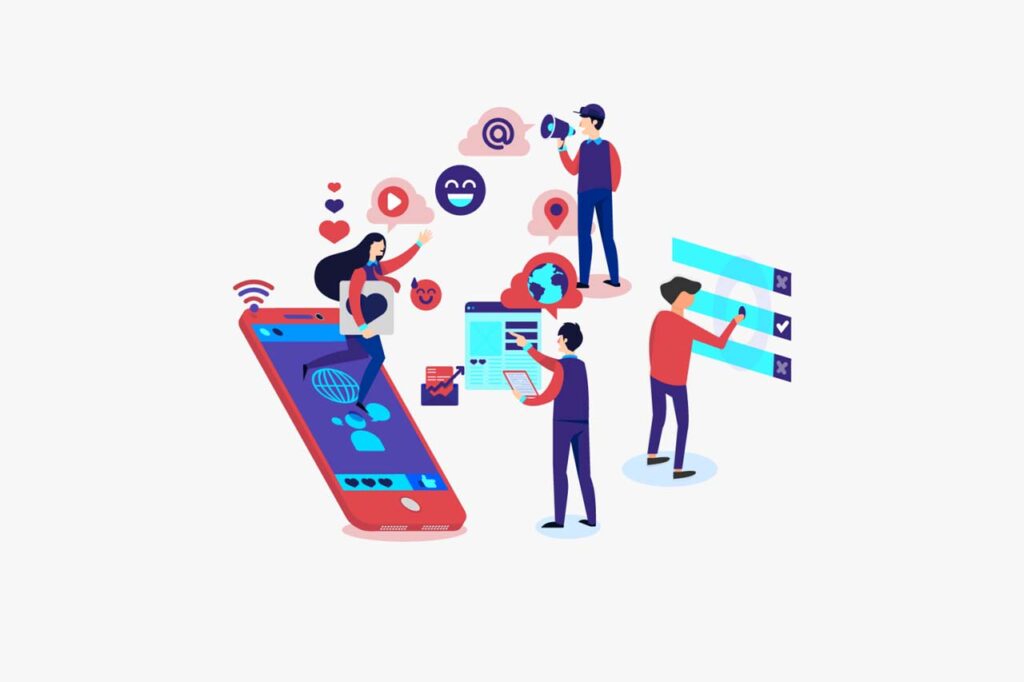
Hey there! Let’s talk about the clash of the titans: print media vs. digital design. As a design agency, we’ve seen it all – from eye-catching poster designs to sleek digital layouts. But here’s the thing: it’s not about picking sides. It’s about finding that sweet spot where both worlds collide and create something amazing for your brand.
So, what’s on the menu? We’re going to dive into the strengths of print media, explore the power of digital design, and show you how to mix and match these two for maximum impact. We’ll look at how brochure design and info graphics can work hand in hand with their digital counterparts. Trust me, by the end of this, you’ll be a pro at balancing the old school charm of print with the flashy allure of graphic design in the digital realm.
Understanding the Strengths of Print Media
Print media has a unique charm that continues to captivate audiences in our digital age. As a design agency, we’ve seen firsthand how print can make a lasting impression on consumers. Let’s dive into why print media still packs a punch in today’s marketing landscape.
Tangibility and Credibility
One of the biggest advantages of print media is its physical presence. When you hold a brochure or flip through a magazine, you’re engaging with the content in a way that feels more personal and memorable. This tactile experience creates a deeper connection between the brand and its audience.
But it’s not just about the feel – print media also carries a sense of trustworthiness. In fact, 82% of internet users trust print ads when making a purchase decision more than any other medium [[1]]. This trust extends to advertising as well, with consumers viewing print advertisements as more credible and engaging than their digital counterparts.
The permanence of print also adds to its credibility. Once something is printed, it can’t be easily altered or deleted, creating an implicit sense of accountability. This permanence allows print ads to have a longer lifecycle. A single magazine purchase might lead to dozens of people seeing your ad in waiting rooms or on coffee tables.
Precise Color Reproduction
When it comes to poster design or brochure design, color accuracy is crucial. Print media shines in this aspect, offering precise color reproduction that can make your designs pop. The ability to use specific color systems like CMYK or Pantone allows for consistent and accurate color representation across different print materials.
For instance, using a five-color method that combines the four-color process (Cyan, Magenta, Yellow, and Black) with a spot color can accurately reproduce specific brand colors [[2]]. This level of precision helps maintain brand consistency and creates visually appealing materials that grab attention.
Lasting Impressions
Print media has a unique ability to create lasting impressions. Unlike digital ads that can be quickly scrolled past, print materials have staying power. A well-designed brochure or poster can remain in a person’s home or office for weeks or even months, providing multiple opportunities for engagement.
Moreover, print media engages multiple senses. The texture of the paper, the weight of a brochure, and even the scent of ink provide a multisensory experience that enhances emotional connection and memory retention. Studies suggest that reading on paper can improve comprehension and recall compared to reading on a screen [[3]].
This sensory engagement extends to creative expressions through various formats, binding styles, and paper types. As a design agency, we can leverage these elements to create unique, eye-catching designs that stand out and leave a lasting impact on your audience.
In conclusion, while digital design certainly has its place in modern marketing strategies, the strengths of print media shouldn’t be overlooked. Its tangibility, credibility, color accuracy, and ability to create lasting impressions make it a powerful tool in any brand’s arsenal. By striking a balance between print and digital, we can create comprehensive marketing strategies that engage audiences across multiple touchpoints, maximizing brand success.
Leveraging the Power of Digital Design
We can’t ignore the impact of digital design on brand success. As a design agency, we’ve seen firsthand how digital design has revolutionized the way businesses connect with their audiences. Let’s dive into the key advantages of digital design and how it complements print media to create a powerful marketing strategy.
Reach and Interactivity
One of the biggest perks of digital design is its ability to reach a global audience. Unlike print media, which has physical limitations, digital design allows us to connect with potential customers worldwide. This online accessibility has opened up a world of growth opportunities for businesses [[1]].
But it’s not just about reaching more people; it’s about engaging them too. Digital design is inherently interactive, allowing users to share blog posts, like photos, save videos, or click on ads [[2]]. This two-way communication helps build a loyal customer base and can lead to higher sales and customer retention.
The best part? We can measure all these interactions. This data helps us create even more engaging content to boost brand awareness or increase sales [[2]]. For instance, we’ve found that web pages and articles with at least one visual get more engagement than those without [[3]]. This insight guides our design decisions, ensuring we create content that resonates with the audience.
Real-time Updates
Another game-changer in digital design is the ability to make real-time updates. Unlike print media, which is static once produced, digital content can be tweaked and optimized on the fly.
Real-time data analytics allow us to understand customer preferences, interests, and product performance as they happen [[4]] This means we can tailor our marketing campaigns to get better results for our clients’ products quickly. We’re not waiting weeks or months to see if a campaign is working – we can make adjustments almost instantly.
For example, we can monitor shopping carts in apps or websites to see which products are getting more attention from consumers [[4]]. If a user abandons their cart, we can use this information to send them a special offer, enticing them to complete their purchase.
Multimedia Integration
Digital design shines when it comes to integrating various forms of media. While print media is limited to static images and text, digital platforms allow us to incorporate videos, animations, interactive elements, and more.
Video content, in particular, has become a powerful tool in digital design. It has an unparalleled ability to capture and retain attention. Studies show that users are more likely to engage with video content than with static images or text alone [[5]].
Moreover, multimedia elements like video can evoke emotions in ways that print media often can’t. Through music, narration, or compelling visuals, we can create powerful emotional connections with the audience [[5]]. This emotional engagement makes the content more likely to be shared and remembered.
For businesses, video is invaluable for showcasing products or services. Through product demonstrations, testimonials, or virtual tours, potential customers gain a deeper understanding of what’s being offered [[5]]. This transparency builds trust and confidence, often leading to higher conversion rates.
In conclusion, while print media still has its place in marketing strategies, digital design offers unique advantages that can’t be ignored. Its global reach, interactivity, real-time updates, and multimedia integration capabilities make it a powerful tool for brand success. As a design agency, we believe the key lies in striking the right balance between print and digital, creating a [comprehensive strategy](https://www.urbangekodesign.com/portfolio/mfour-mfour-branding-powerpoint-website/) that leverages the strengths of both mediums.
Integrating Print and Digital Strategies
We’ve seen the strengths of print media and digital design, but the real magic happens when we blend these two powerhouses together. As a design agency, we’ve found that combining print and digital strategies can lead to some seriously impressive results. Let’s dive into how you can make this dynamic duo work for your brand.
Consistent Brand Identity
First things first, let’s talk about maintaining consistent brand communication across both print and digital platforms. This is crucial for building trust and recognition with your audience. When your brochures, posters, and digital designs all speak the same visual language, it creates a cohesive experience for your customers.
One study found that brand consistency can increase profitability by more than 20% [[1]]. That’s a pretty sweet deal, right? To achieve this, we recommend creating detailed brand guidelines that cover everything from your color palette to your tone of voice. This way, whether someone’s looking at your poster design or scrolling through your website, they’ll instantly recognize your brand.
Cross-channel Promotion
Now, let’s talk about how print and digital can work together to boost your marketing efforts. By using print as an extension of your digital marketing, your campaigns can go even further than with digital alone [[2]]. For example, you can use QR codes on your print materials to direct people to your website or social media pages. It’s like creating a bridge between the physical and digital worlds.
Here’s a cool stat for you: engaging customers with both emails and print marketing led to a 49% increase in sales and a 125% increase in product inquiries [[3]]. That’s the power of cross-channel promotion in action!
Hybrid Campaigns
Hybrid campaigns are where things get really exciting. These campaigns blend print and digital advertising methods to affordably reach the most people and convert prospects into customers [[4]]. For instance, you could start with a direct mail campaign and follow up with targeted digital ads. This approach allows you to reinforce your message across multiple touchpoints.
One study found that using a combination of both print and digital media (email, social media, mobile sites) can increase the effectiveness of your campaigns by 200% [[5]]. That’s double the impact! And the best part? This works for companies of all sizes, from small businesses to large corporations.
To make the most of your hybrid campaigns, consider these tips:
1. Use print to drive traffic to your digital channels. Include your social media handles on all printed marketing materials.
2. Create interactive print media like scratch-offs or quiz games, with answers available online. This gets customers excited about your brand and encourages them to explore your online content.
3. Use variable data printing to personalize your print materials based on digital data. This allows for highly targeted campaigns that feel personalized to each recipient.
4. Include a teaser for a piece of content on your printed material, then direct customers to your website or email newsletter to view the rest.
Remember, the key is to choose the right combination of print and digital channels for each marketing campaign and target audience. What works for one campaign might not be the best fit for another.
By integrating print and digital strategies, you’re creating a comprehensive marketing approach that leverages the strengths of both mediums. You’re giving your audience multiple ways to engage with your brand, reinforcing your message, and ultimately driving better results. So, why choose between print and digital when you can have the best of both worlds?
Conclusion
The integration of print media and digital design offers a powerful approach to brand success. By leveraging the strengths of both mediums, businesses can create a comprehensive marketing strategy that engages audiences across multiple touchpoints. The tangible nature of print media, combined with the interactivity and reach of digital platforms, allows for a multi-faceted approach that has an influence on brand recognition and customer engagement.
In the end, striking a balance between print and digital is key to maximizing brand impact. By maintaining consistency across both channels and implementing cross-promotion strategies, businesses can create a cohesive brand experience that resonates with their audience. Get in touch with us today and schedule your complimentary 15-min consult. Remember, the right mix of print and digital can lead to increased brand loyalty, better customer retention, and ultimately, greater business success.
## References
[1] – https://www.wcdconnect.com/blog/print-design-vs-digital-design-understanding-the-differences
[2] – https://www.linkedin.com/pulse/graphic-design-print-vs-digital-whats-difference-moeez-ahmed
[3] – https://www.indesignskills.com/tutorials/difference-between-digital-design-and-print-design/
[4] – https://wearebluegrass.com/blog/differences-between-print-and-digital-design/
[5] – https://fullsail.media/balancing-print-and-digital-marketing/























